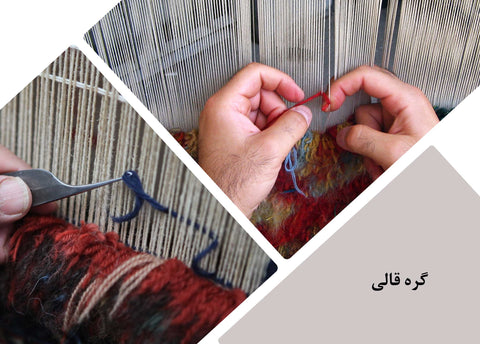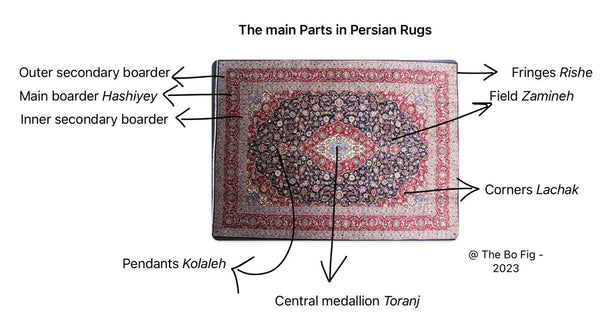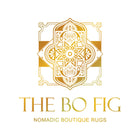"In many cultures the upper crossbeam of the loom is called the beam of heaven, the bottom representing the earth, as if in between the world is being woven into creation.”
Introducing you to the exciting world of hand-knotted Persian Rugs – a world of infinite interlaces of patterns and colours that has remained an objective art for centuries. We offer the reader an understanding that is both original and creative in the art of oriental rug, as well as the benefits of including these handcrafted rugs in your decorating plans for your home, physical and mental workspace, and social gatherings on the floor as needed.
While a variety of weavings are mentioned in ancient writings, the origin of handwoven oriental rugs is uncertain. The earliest known as, the Pazyryk carpet, dates back to 5th century B.C. The Islamic conquest of Persia and the Seljuk dynasty in 7 and 10th century A.D. was a new era of carpet weaving in that region. Finally, the 16th century A.D., the Safavid dynasty ruled Persia and promoted the arts, including carpet weaving.
During the Islamic period, Persian carpet weaving reached new heights of sophistication. The carpets of this period were characterized by their symbolic designs, arabesques with rich colours, and high-quality hand spawn materials. Persian carpets were also woven in tribal families and nomadic tents as living symbols, and the crafts skills were often hidden from European manufacturers such that the secrets to the art would stay alive only in the hands of artists.
This is considered to be the golden age of Persian carpet weaving and yet it has continued to thrive, despite political and economic challenges till early 1980’s. Unfortunately, the production of "Persian-designed" carpets in India, Pakistan, and China has diluted the support and power of the authentic Persian rug craft. Mass production has replicated the art, but not the essence. As a result, the art and skills of Persian rug weaving have suffered.
Persian carpets made in other countries are often bought and sold as authentic Persian rugs, deceiving consumers. It is important to be aware of this when purchasing a Persian rug, and to do your research to ensure that you are getting a genuine product. Despite the decline of the Persian rug market, the finest and most authentic carpets in the world can still be found in the bazaars of Iran. These are prized for their notable beauty, craftsmanship, and durability. They are also considered to be a good investment, as they can last for many generations. They have been traded throughout the world for centuries, and have helped to spread the art of Persian culture and influence. They are a unique and beautiful art form, and it is important to support the artisans who continue to weave them using traditional methods.
The fundamentals of rug making:
“Weaving carpet is the act of creating by interlacing two or more sets of threads combined with knotting. It is a metaphor for the mystery of existence, where time, space, and the visible and invisible worlds are woven together. This weaving is also a creative act, where the weaver makes something out of their own substance.”
Persian rugs are handwoven craft and they do vary in quality. Wool quality, intricacy of design, and knot density are the three main factors that determine the quality of a Persian rug:
* Wool quality: Persian rugs are typically made from sheep's wool, but other types of wool, such as goat's wool or camel's wool, may also be used. The quality of the wool is determined by the length of its fibres, springiness, and luster.
* Intricacy of design: Persian rugs come in a wide variety of designs, from simple geometric patterns to complex floral and animal motifs. The more intricate the design, the more experienced the craftsman must be to weave the pattern.
* Knot density: Knot density is the number of knots tied per square inch of the rug. The higher the knot density, the finer the detail in the design and the more labor-intensive the production.
Machine-made carpets or industry handmade rugs are manufactured to precise tolerances, but hand-knotted rugs from the traditional weavers reflect the human element that is not to be seen in the modern rugs. Each rug is unique, reflecting the individual weaver's story and interpretation of nature around them. The author, The Bo Fig, invites readers to discover the fascinating and exotic world of Persian rugs and to see for themselves how their use can enrich a living environment.
The process of the craft:
"The weaver recites a blessing when cutting the threads of a finished carpet, similar to the blessing uttered by a midwife when cutting the umbilical cord of a newborn baby. The image of the loom as a symbol of creation is powerful and meaningful. Weaving is an act of creation, and the loom is a tool that allows us to bring our visions to life."
Persian rugs are typically made from wool that has been shorn from sheep. The quality of the wool depends on the sheep's breed and diet, the local climate, and the shearing season. After shearing, the wool is washed, carded, and then spun into yarn. The yarn is then dyed in a variety of colours and dried in the sun.
A detailed illustration of the carpet design, also known as a pattern template, serves as a blueprint for the weavers throughout the entire rug-making process. It is rendered on graph paper to scale, with each square on the paper representing one or more knots on the rug, depending on the desired knot density. The pattern is typically created by a master designer who has a deep understanding of the different types of Oriental rug designs and weaving techniques. The designer considers factors such as the size of the rug, the type of wool to be used, and the desired knot density when creating the pattern. Once the pattern is complete, it is transferred to the loom by the weavers. The weavers follow the pattern carefully, knotting the yarn according to the design. The Pattern is essential for ensuring that the rug is woven accurately and that the design is realized as intended.
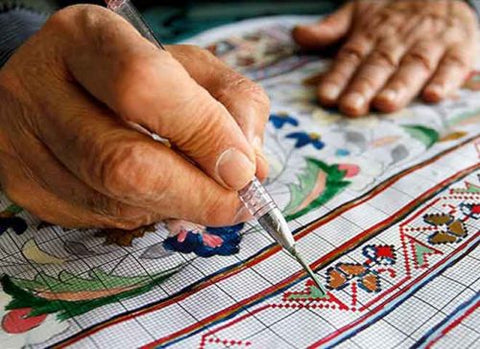
Persian rug looms have remained relatively unchanged over the centuries. The most common type of loom used today consists of two vertical beams and two horizontal beams. The distance between the vertical beams determines the width of the rug. Warp threads, usually made of cotton, are strung between the horizontal beams at a consistent tension. The thickness of the warp threads and the closeness at which they are strung determine the fineness of the weave (i.e., knot density) of the carpet.
There are two main types of knots used in Persian rug weaving: the Turkish knot and the Persian or Senneh knot. The Turkish knot is symmetrical, while the Persian knot is asymmetrical. The average weaver can tie 10,000 to 14,000 Turkish or Persian knots a day, but it still takes several weavers working together several days to complete a few inches of a carpet.
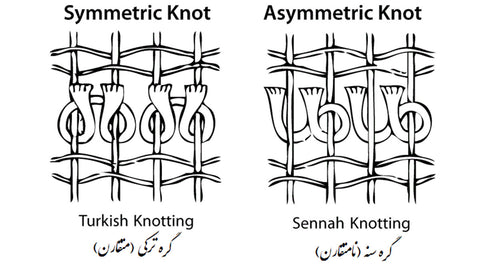
Before knotting begins, the rug is secured at the bottom of the loom with a kilim, a flat pileless textile. The weaver then begins weaving the rug, following the design on the pattern template. The weaver ties knots around two adjacent warp threads, slides the knots down to the base of the weft, and then cuts the yarn with a knife, thereby producing the pile. After each row of knots is completed, one or more weft threads are inserted to secure the knots and are beaten down tightly with a comb. At this stage, the pile ends are often cut level with a pair of shears. The alternation of wefts with rows of tied knots is repeated until the carpet is finished. Before removing the rug from the loom, another kilim is woven at the top. The fringe is formed by cutting the warps at both ends of the rug.
After the rug has been cut off the loom, the final finishing steps take place. The selvedge edges (i.e. side edges of the rug formed by the continuous weft) are bound or overcast with yarn to reinforce them. The warp ends are then knotted or braided to form the rug's fringe. The rug is then washed to eliminate dust and dirt and to impart a sheen and luster to the wool.

Persian rugs are a true form of objective art and craftsmanship. They are hand-knotted using traditional methods and materials, and each rug is unique and individual that has been past down from one generation to another by heart and soul. They are prized for their beauty, durability, and investment value. If you are considering purchasing an authentic Persian rug, there are a few things you should keep in mind. First, it is important to understand the different factors that determine the quality of a Persian rug, such as wool quality, intricacy of design, and knot density. Second, you should be prepared to invest some amount of money in a high-quality Persian rug. However, it is important to remember that a Persian rug is a valuable investment that will last for decades and has stories to pass on to next generations.
